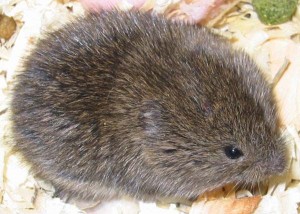 Philosophy Bites is one of my favorite podcasts. There’s a new one every week or so, and I enjoy them all. It’s an easy way to get some quick and easy exposure to important philosophical issues. Earlier this month I listened to a conversation with Pat Churchland on “What Can Neuroscience Teach Us About Morality”. I’ll give you the shorthand version of the conversation, which got me thinking about some difficult questions.
Philosophy Bites is one of my favorite podcasts. There’s a new one every week or so, and I enjoy them all. It’s an easy way to get some quick and easy exposure to important philosophical issues. Earlier this month I listened to a conversation with Pat Churchland on “What Can Neuroscience Teach Us About Morality”. I’ll give you the shorthand version of the conversation, which got me thinking about some difficult questions.
Unlike some reptiles and many fish, we don’t eat our young. It turns out that our brains, like all mammalian brains, are organized so that we are inclined to care for and nurture our young. Both mothers and their offspring feel pain when separated and pleasure when united. This mother-infant bonding isn’t a societal or cultural response, but rather a hard-wired chemically driven physical response, attributable to oxytocin, or more specifically, to the way we respond to oxytocin.
 Now, oxytocin, a hormone, isn’t something cooked up by a modern pharmaceutical company. It is a very old molecule, but very important in evolution. Because mammals are born in a very immature state, and are unable to care for themselves, mother-infant bonding can be crucial to survival. So, in mammals, the brain has evolved to favor individuals that have a predisposition to care for their young, rather than abandoning them. Certain portions of the frontal and re-frontal lobes of the brain contain high concentrations of neurons that are highly receptive to oxytocin, and a related chemical, vasopressin. When those oxytocin-receptor neurons are in the same brain locations that control nurturing behavior–Viola!–we get more nurturing behaviors and stronger mother-infant bonds, probably because the nurturing behaviors activate pleasure centers in the brain. In laymen’s terms, nurturing behaviors make the mother feel good, while at the same time being good for the evolutionary success of the species.
Now, oxytocin, a hormone, isn’t something cooked up by a modern pharmaceutical company. It is a very old molecule, but very important in evolution. Because mammals are born in a very immature state, and are unable to care for themselves, mother-infant bonding can be crucial to survival. So, in mammals, the brain has evolved to favor individuals that have a predisposition to care for their young, rather than abandoning them. Certain portions of the frontal and re-frontal lobes of the brain contain high concentrations of neurons that are highly receptive to oxytocin, and a related chemical, vasopressin. When those oxytocin-receptor neurons are in the same brain locations that control nurturing behavior–Viola!–we get more nurturing behaviors and stronger mother-infant bonds, probably because the nurturing behaviors activate pleasure centers in the brain. In laymen’s terms, nurturing behaviors make the mother feel good, while at the same time being good for the evolutionary success of the species.
Recent discoveries regarding mate attachment seem to demonstrate that the same type of attachments that occur in mother-infant bonds can develop in mating pairs. In a classic study, monogamous prairie voles are compared to polygamous montane voles. Prairie voles bond for life after mating [alas, the same is not true for humans]. Males guard the nest, take care of offspring, and basically hang out together with their mates for life. Montane vole mothers bond with their infants, but the fathers–well, they mate and go on their merry way.
 The only difference in the brains of the prairie and montane voles is the location of the oxytocin and vasopressin receptors where the chemicals bind–the density and location of receptors is very different in prairie and montane voles. Experiments have shown that if you manipulate the receptors you change the behaviors. Ecological factors also have a bearing, but it is relatively minor. So, we see that small changes in genetics can lead to very large behavior changes, not only with maternal and mate bonding, but also with kith bonding, which is bonding with friends, neighbors and relatives. The advantages of kith bonding can be obvious. A common example is that of wolf packs versus lone wolves, where both protection and predatory success are enhanced when living and working as a pack.
The only difference in the brains of the prairie and montane voles is the location of the oxytocin and vasopressin receptors where the chemicals bind–the density and location of receptors is very different in prairie and montane voles. Experiments have shown that if you manipulate the receptors you change the behaviors. Ecological factors also have a bearing, but it is relatively minor. So, we see that small changes in genetics can lead to very large behavior changes, not only with maternal and mate bonding, but also with kith bonding, which is bonding with friends, neighbors and relatives. The advantages of kith bonding can be obvious. A common example is that of wolf packs versus lone wolves, where both protection and predatory success are enhanced when living and working as a pack.
Darwin knew this. Plato did too; he talked about humans as social animals. But why does any of this matter?
To answer this question, we have to take a step backward in order to make progress. Mammalian brains are all very similar, so it seems highly likely that the earliest human social institutions were probably very similar to those of chimpanzees. However, when humans started creating societal institutions to deal with the problems of social living, they developed cultural rules that developed into what we now call Morality.
 Not wanting to get caught up in an argument about exactly what we mean by morality, let’s suppose we agree [I do!] with the great Scottish philosopher David Hume, and that, like Hume, we see social behavior on a spectrum. Some matters are like good manners, nice but not critical. On the other end there are crucial matters that are much more important, such as the “thou shalt not kill.” There is a dividing line, but the boundaries between etiquette or social convention–the nice but not terribly important things– and morality–the very important stuff–tend to be fuzzy. They may differ between and even within cultures. We see this type of divide over morality today in political debates, when candidates claim a specific moral basis for their stance on issues.
Not wanting to get caught up in an argument about exactly what we mean by morality, let’s suppose we agree [I do!] with the great Scottish philosopher David Hume, and that, like Hume, we see social behavior on a spectrum. Some matters are like good manners, nice but not critical. On the other end there are crucial matters that are much more important, such as the “thou shalt not kill.” There is a dividing line, but the boundaries between etiquette or social convention–the nice but not terribly important things– and morality–the very important stuff–tend to be fuzzy. They may differ between and even within cultures. We see this type of divide over morality today in political debates, when candidates claim a specific moral basis for their stance on issues.
So how do we, as individuals, know where to draw the lines? Where should our society draw those lines? Which issues are truly issues of basic morality,and which are merely questions of custom or cultural expectations? Whose morality is the true morality?
There are no easy answers to those questions. Neuroscience doesn’t have anything to say about most “moral” questions. At best, it can be helpful in a few highly limited limited domains. For example, neuroscience does tell us that the development of the pre-frontal lobes–where discipline and control of impulses is lodged–is not completed in humans until about eighteen years of age, providing a strong argument that we shouldn’t treat juveniles the same way we treat adults, even if they commit a heinous crime. But neuroscience provides no guidance at all on matters such as the fairness of inheritance taxes, or the rightness and justness of any particular war. We have no hard-wiring to help us out, and have to rely on our rationality and emotions to decide what is right: what we ought to do.
So now comes the trick question, the one that inspired me to write this article: If we could put oxytocin in the water supply or spray it in the air so that people would be more inclined to like each other, to reduce violence and violent behavior, should we do it? Why not shower the Middle East with oxytocin?
Beyond the unfortunate fact that it probably wouldn’t do any good, that no “love each other” spray effective over large populations is in the cards (though the idea of a Love Vaccine is not out of the question), and ignoring the fact that oxytocin performs other critical functions, such as regulating female reproductive cycles, would it be a good idea? Would you take the pill, or the injection, or the aerosol spray if it were available? Would you give it to others? Would it be the right thing to do, a moral thing to do?
 I’m not at all sure. I think there is a lot more to love and personal attachment than chemical reactions in our brains. Hormones may pre-dispose certain types of behaviors, but we still make choices–rational and emotional choices–about who we choose to love and why we choose to love them. I’d like to think I can make those choices freely, and that I have sufficiently good moral sense to love my neighbor, without chemical assistance, even if I don’t like him that much.
I’m not at all sure. I think there is a lot more to love and personal attachment than chemical reactions in our brains. Hormones may pre-dispose certain types of behaviors, but we still make choices–rational and emotional choices–about who we choose to love and why we choose to love them. I’d like to think I can make those choices freely, and that I have sufficiently good moral sense to love my neighbor, without chemical assistance, even if I don’t like him that much.
I think it could be tried on a limited population basis and based upon the results, go from there. Whatever might work would be better than all the hate and killings.
What if we sprayed the RNC? Perhaps we all would be like Puck….in love with a jackass.
Don’t overlook the “social gene” …..we share it , not with other primates but only with “social ants.” We are the only two creatures that will sacrifice the individual on behalf of the group (RNC excepted). (see E. Wilson)